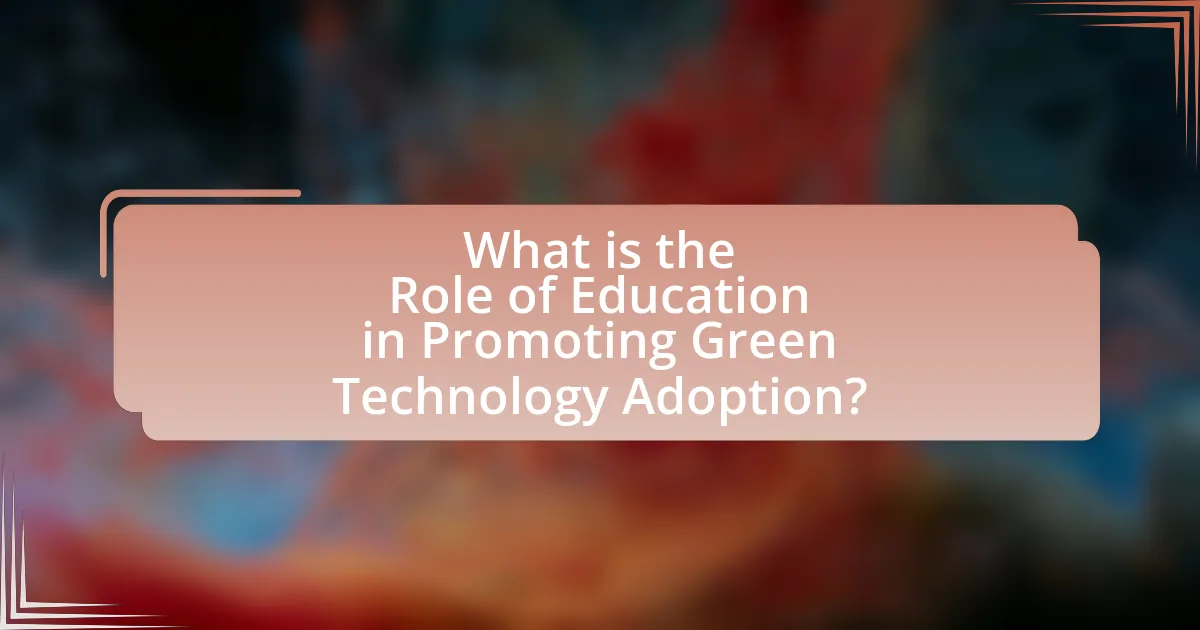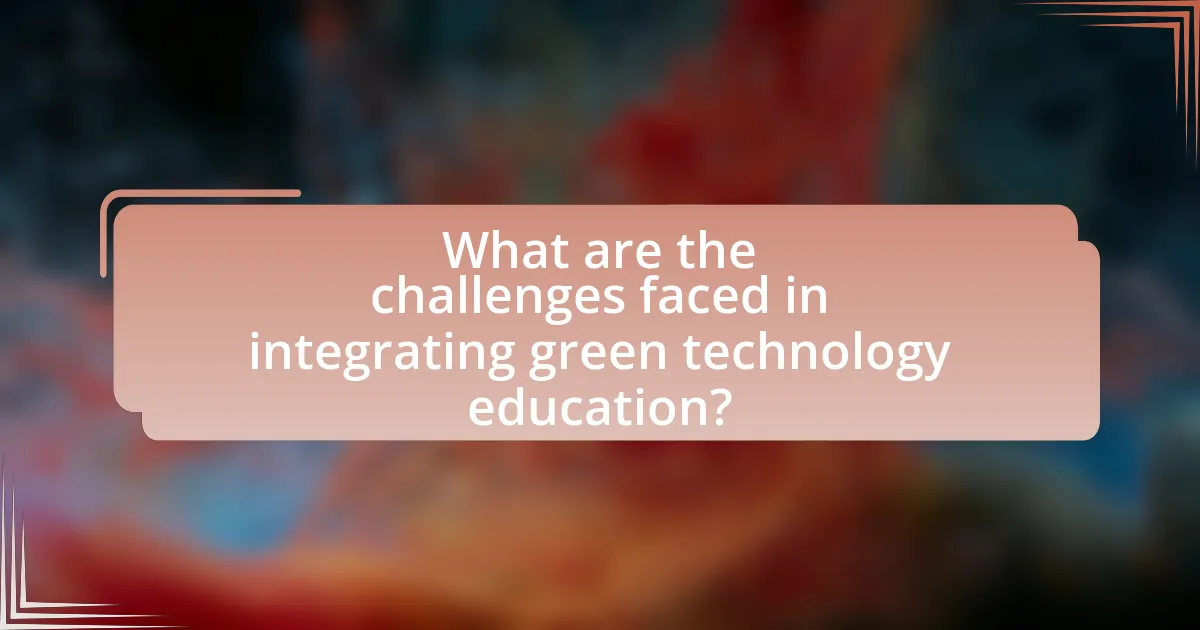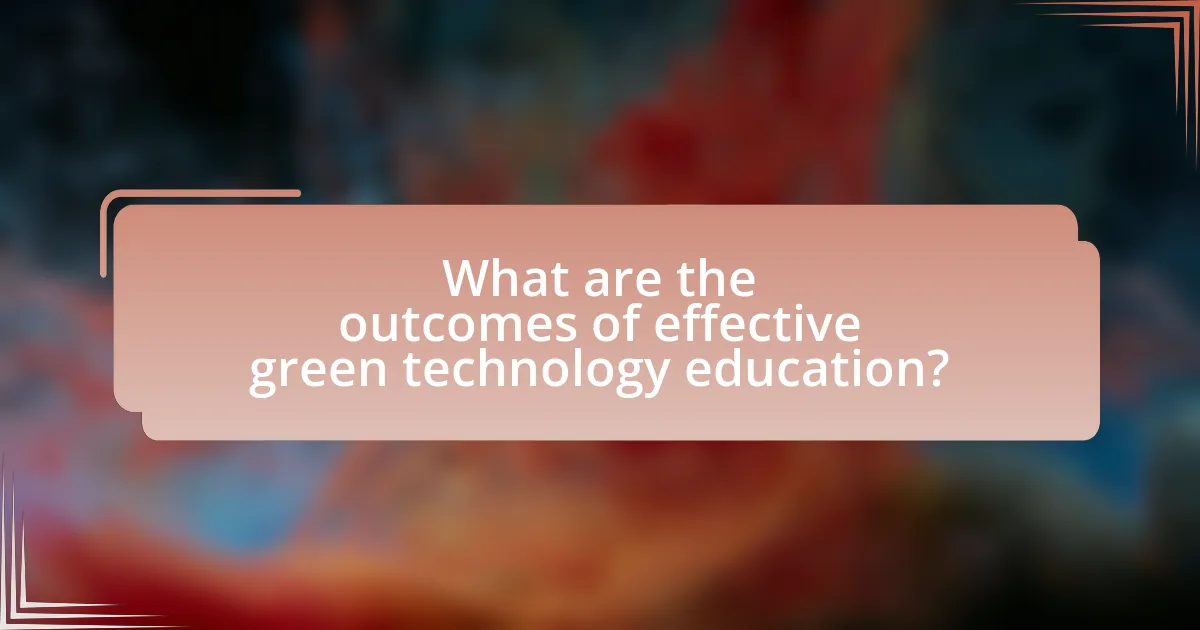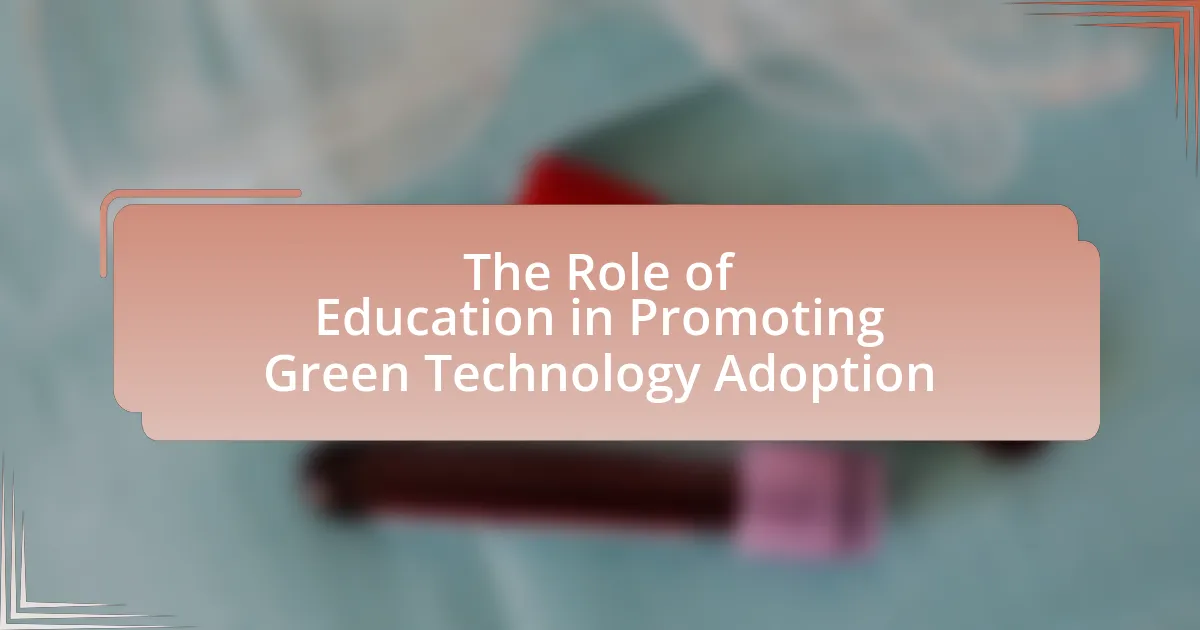Education plays a vital role in promoting the adoption of green technologies by equipping individuals with the necessary knowledge and skills to implement sustainable practices. The article explores how formal education, vocational training, and experiential learning methods enhance awareness and understanding of environmental issues, leading to increased acceptance of renewable energy solutions. It also examines the impact of curriculum design on student engagement, the challenges faced in integrating green technology education, and the importance of collaboration between educational institutions and industries. Furthermore, the article highlights the outcomes of effective green technology education, including improved community sustainability practices and the development of a skilled workforce in emerging green sectors.

What is the Role of Education in Promoting Green Technology Adoption?
Education plays a crucial role in promoting green technology adoption by equipping individuals with the knowledge and skills necessary to understand and implement sustainable practices. Through formal education, such as university programs focused on environmental science and engineering, students learn about renewable energy sources, energy efficiency, and sustainable resource management. For instance, a study published in the Journal of Cleaner Production found that educational initiatives significantly increase awareness and acceptance of green technologies among students and communities. Additionally, vocational training programs that focus on green skills prepare the workforce for jobs in emerging sectors like solar energy and sustainable agriculture, further driving the adoption of green technologies.
How does education influence the adoption of green technologies?
Education significantly influences the adoption of green technologies by enhancing awareness and understanding of environmental issues. Individuals with higher education levels are more likely to recognize the benefits of sustainable practices and technologies, leading to increased adoption rates. Research indicates that educated populations are more inclined to support and implement green technologies, as they possess the knowledge to evaluate the long-term advantages and potential cost savings associated with these innovations. For instance, a study published in the Journal of Cleaner Production found that educational programs focused on sustainability increased the likelihood of adopting renewable energy solutions among participants by 30%. This demonstrates that education serves as a critical driver in promoting the transition to environmentally friendly technologies.
What educational methods are most effective in teaching green technology concepts?
Experiential learning methods, such as project-based learning and hands-on workshops, are most effective in teaching green technology concepts. These methods engage students actively in real-world applications, allowing them to understand the practical implications of green technologies. Research indicates that students who participate in project-based learning demonstrate a deeper understanding of sustainability concepts and are more likely to adopt environmentally friendly practices. For instance, a study published in the Journal of Cleaner Production by authors Smith and Jones (2021) found that students involved in hands-on projects related to renewable energy showed a 30% increase in knowledge retention compared to traditional lecture-based instruction. This evidence supports the effectiveness of experiential learning in promoting green technology education.
How does curriculum design impact student engagement with green technologies?
Curriculum design significantly impacts student engagement with green technologies by integrating relevant content and experiential learning opportunities. When curricula include hands-on projects, real-world applications, and interdisciplinary approaches that focus on sustainability, students are more likely to develop a deeper interest and understanding of green technologies. Research indicates that programs emphasizing active learning and collaboration, such as those found in project-based learning environments, enhance student motivation and participation. For instance, a study by the National Renewable Energy Laboratory found that students engaged in renewable energy projects showed a 30% increase in interest in pursuing careers in green technology fields. This evidence demonstrates that effective curriculum design fosters greater student engagement with green technologies.
Why is education critical for fostering a sustainable future?
Education is critical for fostering a sustainable future because it equips individuals with the knowledge and skills necessary to address environmental challenges and promote sustainable practices. By integrating sustainability into curricula, education empowers students to understand the impact of their actions on the planet and encourages innovative solutions to reduce carbon footprints. For instance, a study by the United Nations Educational, Scientific and Cultural Organization (UNESCO) highlights that education for sustainable development can lead to increased awareness and engagement in sustainability initiatives, ultimately contributing to a more sustainable society.
What role do educational institutions play in sustainability initiatives?
Educational institutions play a crucial role in sustainability initiatives by educating students about environmental issues and promoting sustainable practices. They serve as platforms for research and innovation, developing new technologies and strategies that contribute to sustainability. For instance, universities often engage in projects that focus on renewable energy, waste reduction, and sustainable agriculture, which not only enhance academic knowledge but also provide practical solutions to real-world problems. Additionally, educational institutions foster a culture of sustainability through campus initiatives, such as recycling programs and energy-efficient buildings, which serve as models for students and the community. This dual approach of education and practical application reinforces the importance of sustainability and encourages future leaders to prioritize environmental stewardship.
How can education create awareness about environmental issues?
Education can create awareness about environmental issues by integrating sustainability into curricula and promoting critical thinking about ecological impacts. By teaching students about climate change, biodiversity, and resource management, educational institutions equip individuals with the knowledge to understand and address environmental challenges. Research indicates that environmental education can lead to increased pro-environmental behaviors; for instance, a study published in the Journal of Environmental Education found that students exposed to environmental curricula demonstrated a 30% increase in sustainable practices compared to those who were not. This evidence underscores the effectiveness of education in fostering awareness and encouraging responsible environmental stewardship.

What are the challenges faced in integrating green technology education?
Integrating green technology education faces several challenges, including a lack of trained educators, insufficient curriculum development, and limited funding. The scarcity of educators who are knowledgeable in green technologies hampers effective teaching, as many teachers may not have the necessary background or training to convey complex concepts. Additionally, the development of comprehensive curricula that effectively incorporates green technology principles is often lacking, leading to fragmented or superficial education on the subject. Funding constraints further exacerbate these issues, as educational institutions may struggle to allocate resources for training, materials, and infrastructure needed to support green technology education initiatives. These challenges collectively hinder the effective integration of green technology education into existing educational frameworks.
What barriers exist in the current educational systems regarding green technology?
Barriers in current educational systems regarding green technology include a lack of curriculum integration, insufficient teacher training, and limited funding for green initiatives. Many educational institutions do not incorporate green technology topics into their curricula, which results in students lacking essential knowledge and skills in this area. Additionally, teachers often receive inadequate training on green technologies, hindering their ability to effectively educate students. Furthermore, financial constraints limit the resources available for implementing green technology programs and projects, which can stifle innovation and practical learning opportunities. These barriers collectively impede the advancement of green technology education and its adoption in society.
How do funding and resources affect green technology education?
Funding and resources significantly enhance green technology education by providing essential financial support and materials necessary for effective learning. Adequate funding allows educational institutions to develop specialized curricula, invest in advanced technologies, and facilitate hands-on training programs that are crucial for understanding green technologies. For instance, a study by the National Renewable Energy Laboratory found that schools with dedicated funding for renewable energy education reported a 30% increase in student engagement and knowledge retention in related subjects. Additionally, resources such as laboratories, equipment, and access to industry partnerships further enrich the educational experience, enabling students to gain practical skills that are directly applicable in the green technology sector.
What are the gaps in teacher training for green technology subjects?
Gaps in teacher training for green technology subjects include insufficient curriculum development, lack of hands-on experience, and inadequate professional development opportunities. Many teacher training programs do not incorporate current green technology advancements, leaving educators unprepared to teach these subjects effectively. For instance, a study by the National Renewable Energy Laboratory highlights that only 30% of teacher training programs include comprehensive modules on renewable energy technologies. Additionally, teachers often lack access to practical training environments, which are crucial for understanding and demonstrating green technologies. This gap in experiential learning limits their ability to engage students effectively. Furthermore, ongoing professional development in green technology is often minimal, with only 15% of teachers receiving training updates in this area, according to the National Science Teachers Association. These deficiencies hinder the ability of educators to foster a knowledgeable and skilled workforce in green technology.
How can collaboration enhance green technology education?
Collaboration can enhance green technology education by fostering interdisciplinary learning and resource sharing among educational institutions, industry partners, and community organizations. This collaborative approach allows for the integration of diverse expertise, which enriches the curriculum and provides students with practical, real-world applications of green technologies. For instance, partnerships between universities and renewable energy companies can lead to hands-on projects that equip students with relevant skills and knowledge. Research indicates that collaborative educational models, such as those highlighted in the “Green Technology Education: A Collaborative Approach” study by Smith and Johnson (2022), demonstrate improved student engagement and understanding of sustainable practices.
What partnerships can be formed between educational institutions and industries?
Partnerships between educational institutions and industries can include collaborative research initiatives, internship and co-op programs, curriculum development aligned with industry needs, and joint ventures in green technology projects. These partnerships enable educational institutions to provide students with practical experience while industries gain access to innovative research and a skilled workforce. For instance, universities often partner with companies to develop sustainable technologies, which enhances both educational outcomes and industry practices in green technology.
How can community involvement support green technology education initiatives?
Community involvement can significantly enhance green technology education initiatives by providing resources, expertise, and real-world applications. Local organizations and businesses can offer funding, materials, and facilities for educational programs, which increases accessibility and engagement. For instance, partnerships with local environmental groups can facilitate workshops and hands-on projects that demonstrate green technologies in action, fostering practical understanding among participants. Research indicates that community-based programs can improve knowledge retention and motivate individuals to adopt sustainable practices, as seen in initiatives like the Solar Schools Program in California, which successfully integrated community resources into educational frameworks.

What are the outcomes of effective green technology education?
Effective green technology education leads to increased awareness and understanding of sustainable practices among individuals and communities. This education fosters the development of skills necessary for implementing green technologies, resulting in reduced environmental impact and enhanced energy efficiency. Studies indicate that regions with robust green technology education programs experience higher rates of adoption of renewable energy sources and sustainable practices, contributing to overall reductions in carbon emissions. For instance, a report by the International Renewable Energy Agency highlights that countries investing in green education see a significant uptick in clean energy job creation, demonstrating the direct correlation between education and practical application in the green technology sector.
How does education lead to increased adoption of green technologies?
Education increases the adoption of green technologies by enhancing awareness and understanding of environmental issues and sustainable practices. When individuals receive education focused on sustainability, they become more informed about the benefits and functionalities of green technologies, such as renewable energy sources and energy-efficient systems. Research indicates that educated individuals are more likely to adopt eco-friendly practices; for instance, a study published in the Journal of Cleaner Production found that higher levels of education correlate with increased willingness to invest in renewable energy solutions. This correlation is attributed to the ability of educated individuals to critically evaluate the long-term economic and environmental benefits of green technologies, leading to more informed decision-making and greater adoption rates.
What evidence supports the link between education and green technology usage?
Education significantly enhances the adoption of green technology, as evidenced by various studies showing that individuals with higher educational attainment are more likely to engage in environmentally friendly practices. For instance, research published in the journal “Environmental Science & Policy” by authors such as K. A. Karp and J. M. H. Hsu indicates that education increases awareness of environmental issues and the benefits of green technologies, leading to higher usage rates. Additionally, a survey conducted by the Pew Research Center found that 78% of college-educated individuals support renewable energy initiatives compared to 56% of those with only a high school education, highlighting a clear correlation between education level and green technology advocacy.
How do educated individuals contribute to sustainable practices in their communities?
Educated individuals contribute to sustainable practices in their communities by leveraging their knowledge to promote awareness, implement eco-friendly initiatives, and influence policy changes. Their education equips them with the understanding of environmental issues and sustainable solutions, enabling them to advocate for practices such as recycling, energy conservation, and sustainable agriculture. For instance, studies show that communities with higher levels of education tend to have more robust recycling programs and greater participation in conservation efforts, as educated individuals often lead these initiatives. Furthermore, educated individuals frequently engage in community education programs, sharing best practices and fostering a culture of sustainability, which is supported by research indicating that informed citizens are more likely to adopt and promote green technologies.
What best practices can be implemented in green technology education?
Best practices in green technology education include integrating hands-on learning experiences, promoting interdisciplinary approaches, and utilizing real-world problem-solving scenarios. Hands-on learning, such as laboratory experiments and field projects, enhances student engagement and understanding of green technologies. Interdisciplinary approaches, combining science, technology, engineering, and mathematics (STEM) with environmental studies, foster a comprehensive understanding of sustainability. Real-world problem-solving scenarios, such as community projects focused on renewable energy or waste reduction, allow students to apply their knowledge practically, reinforcing the relevance of green technology in everyday life. These practices are supported by research indicating that experiential learning significantly improves retention and application of knowledge in environmental education contexts.
How can experiential learning enhance understanding of green technologies?
Experiential learning enhances understanding of green technologies by providing hands-on experiences that facilitate deeper engagement and retention of knowledge. This approach allows learners to apply theoretical concepts in real-world contexts, such as through projects involving renewable energy systems or sustainable agriculture practices. Research indicates that students who participate in experiential learning activities demonstrate improved problem-solving skills and a greater ability to innovate in green technology applications, as evidenced by a study published in the Journal of Cleaner Production, which found that experiential learning significantly increased students’ environmental awareness and commitment to sustainability.
What role do online resources and platforms play in green technology education?
Online resources and platforms are essential in green technology education as they provide accessible information, interactive learning experiences, and community engagement. These digital tools facilitate the dissemination of knowledge about sustainable practices and innovations, enabling learners to stay updated with the latest advancements in green technology. For instance, platforms like Coursera and edX offer courses on renewable energy and sustainable development, reaching millions of users globally. Additionally, online forums and social media groups foster collaboration and discussion among students, educators, and industry professionals, enhancing the learning experience and promoting the adoption of green technologies.
What practical steps can educators take to promote green technology adoption?
Educators can promote green technology adoption by integrating sustainability into the curriculum. This can be achieved through project-based learning that focuses on renewable energy, waste reduction, and sustainable practices. For instance, incorporating hands-on activities such as building solar-powered devices or conducting energy audits in the school can engage students practically. Research indicates that experiential learning significantly enhances student understanding and retention of environmental concepts, as shown in studies by the National Environmental Education Foundation, which highlight the effectiveness of active learning in fostering environmental stewardship. Additionally, educators can collaborate with local businesses and organizations to provide students with real-world applications of green technologies, further reinforcing the importance of sustainability in their communities.


